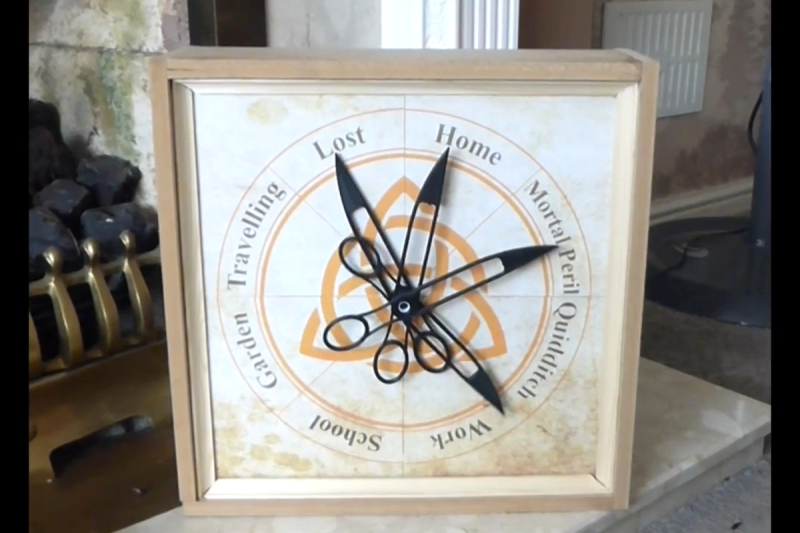For those unfamiliar with the details of the expansive work of fiction of Harry Potter, it did introduce a few ideas that have really stuck in the collective conscious. Besides containing one of the few instances of time travel done properly and introducing a fairly comprehensive magical physics system, the one thing specifically that seems to have had the most impact around here is the Weasley family clock, which shows the location of several of the characters. We’ve seen these built before in non-magical ways, but this latest build seeks to drop the price tag on one substantially.
To do this, the build relies on several low-cost cloud computing solutions and smartphone apps to solve the location-finding problem. The app is called OwnTracks and is an open-source location tracker which can report data to any of a number of services. [Simon] sends the MQTT data to a cloud-based solution called HiveMQCloud, but you could send it anywhere in principle. With the location tracking handled, he turns to some very low-cost Arduinos to control the stepper motors which point the clock hands to the correct locations on the face.
While the build does rely on a 3D printer for some of the internal workings of the clock, this does bring the cost down substantially when compared to other options. Especially when compared to this Weasley family clock which was built into a much larger piece of timekeeping equipment, having an option for a lower-cost location-tracking clock face like this one is certainly welcome.
















Gawd, the safety stuff is a bit overblown. He really doesn’t need to be overly concerned about leaving it running unattended, the probability of it turning into a fireball is minuscule. To anyone thinking of having a go, don’t be put off, it really isn’t that dangerous!
There should be a thermistor in there so it turns to Mortal Peril if the temperature goes too high.
Well we’ve seen from the comments here that if one doesn’t genuflect to neurotically excessive risk aversion, the eternal redditor is activated and moans about it
Yeah, he seems a bit paranoid about that. If people are really worried about their little projects blowing up or catching fire, there is a simple way to regain confidence and allay fears: the Class 2 Power Supply. This is a power supply that produces no more than 60VDC, 30 Vrms, or 42.4 Vp and limits the power when the output reaches 100VA. This is considered a safe amount of power in the NEC/CEC, too small to cause fire or injury, so that devices and wiring connected to the supply don’t need any kind of certification.
To properly qualify the power supply also has to state “Class 2 Power Supply” on the label (not to be confused with the Class II Power Supply, an IEC rating for insulation class). A fused output also counts if it blows at the appropriate current, meaning that you can use a bank of fuses to make multiple Class 2 circuits. Here’s some light reading from my local AHJ on the topic: https://esasafe.com/assets/files/esasafe/pdf/Electrical_Safety_Products/Exceptions-Product-Approval-Requirements.pdf
So if you’re concerned, get one of those – the electrical codes say you should be fine!
Not sure what you’re on about. Thanks though, cuz I actually read the whole thing to see what you meant. I saw 2 remarks on safety in the entire (well-documented) write-up: 1 was a classic disclaimer at the beginning, then there was an “I am not responsible if you don’t verify your own wiring” (and maybe a remark about a Fritzing diagram being theoretical). Does he mention being concerned about leaving it unattended? Maybe I missed something.
Yeah, it was near the end in the “Running It” section:
“I am no electrician and at this stage of the project am a little scared to leave it running unless you are an electrician I advise you to do the same”
OwnTracks is built on top of mqttwarn which has some cool integrations with many other notification services.
Not heard of mqttwarn before, looks nice – discovery is a b on the net these days, even with all the ‘awesome’ lists sprouting on github. My fave atm is deepstream.io – it speaks everything (much more flexible than mqtt on its own) and is u-processor friendly to boot.
K&S Precision Metals is located in Chicago, Illinois so if you are in the U.S. there’s no need to order the Brass Telescopic Tubing from the UK via Etsy:
https://ksmetals.com/
https://ksmetals.com/search?q=Telescopic+Tubing
I noticed [Bryan Cockfield] picked this subtle detail out from the start in his Hackaday post: [Simon] calls his build a Wheresly Clock because it shows a location.[1] I suspect this is cleverly done on purpose, his clock is part of the more complex Weasley’s Family Clock [2] from the Detectors collection of magical objects in the Harry Potter story collection.[3]
* References:
1. WhereslyClock/MyWhereslyClock @ GitHub
https://github.com/WhereslyClock/MyWhereslyClock
2. The Weasleys’ [sic] clock
https://en.wikipedia.org/wiki/File:The_Making_of_Harry_Potter_29-05-2012_(7388833700).jpg
3. Magical objects in Harry Potter – Detectors
https://en.wikipedia.org/wiki/Magical_objects_in_Harry_Potter#Detectors
Now if only someone could create a Jeremy Bearimy clock!
I like the 3d printed gear aspect to couple to four independent stepper motors to the hands on a budget. Definitely overkill to use two additional arduinos as i2c to parallel port io expanders but hey if that’s what he had on hand then more power to him. It’d be easy enough to tweak the design to use cheap 595 serial shift registers and just write the data out of the esp in spi.